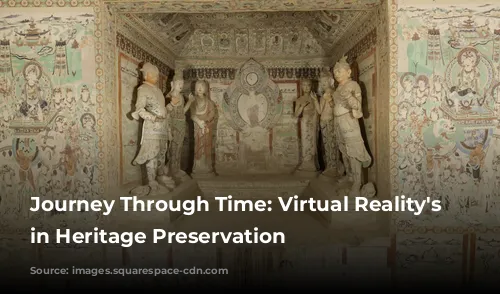Imagine stepping into a breathtaking cave, adorned with vibrant murals that whisper tales of ancient civilizations. But these aren’t just any cave paintings; they’re the Dunhuang Caves, a UNESCO World Heritage Site in China, and they’re changing right before your eyes. With the power of virtual reality (VR), you can witness the murals’ transformation across centuries, watching them deteriorate and fade with time. This immersive experience transports you to another era, offering a glimpse into the past and revealing the cave’s potential grandeur thousands of years ago.
Accessibility is key when exploring these historical treasures. You can experience this virtual cave on your phone using a simple cardboard VR viewer, or for a more immersive adventure, use a headset like Oculus Rift or HTC Vive. The virtual world knows no limitations, allowing access to anyone, anywhere.
Breaking Down Barriers: VR’s Impact on Heritage Access
VR has emerged as a revolutionary force in heritage preservation, offering unique advantages. Its most compelling feature is its ability to immerse users in time and space. This “time travel” experience, as coined by researchers Lijun Ma and Xiaobo Lu from Tsinghua University, allows us to explore ancient sites and interact with them in ways never before possible. VR extends the reach of cultural heritage, transcending the limitations of physical space and time. Projects like the VR Dunhuang Caves and Lithodomos 3D bridge the gap between the past and the present, making heritage more accessible and engaging than ever before.
VR also offers accessibility to a wider audience, including individuals with disabilities. For instance, the Milan Cathedral’s highest section has been inaccessible to the public since the 16th century. VR allows anyone to explore this magnificent structure, revealing hidden secrets and fostering deeper understanding. This democratization of heritage opens doors for everyone to experience the world’s cultural treasures.
Taking this accessibility to the next level, Google has launched the Open Heritage Project in collaboration with VyArk. This ambitious initiative uses VR to create detailed 3D models of 26 heritage sites across 18 nations, including remote and restricted locations. The project makes these sites accessible to a global audience, allowing people to explore ancient ruins, temples, and historical landmarks from the comfort of their homes.
Beyond Exploration: Education and the Future of VR in Heritage
VR’s potential extends far beyond mere exploration. The Open Heritage Project incorporates audio guides and educational games, creating an interactive and engaging learning experience. This platform empowers users to learn about history, culture, and archaeology in a fun and immersive way.
VR also empowers archaeologists and art historians. Restoration suggestions can be tested and modified on the virtual platform, allowing for experimentation and revisions without impacting the physical site. This flexible approach to heritage conservation allows for continuous improvements as our understanding of the past evolves.
Facing the Challenges: Ethical Considerations in VR Heritage Reconstruction
While VR offers numerous benefits, it also presents ethical challenges. Critics argue that VR reconstructions, often based on incomplete evidence, can mislead viewers into believing they are seeing a perfect replica of the past. The risk of misinterpretation and potential oversimplification of complex historical narratives is a significant concern.
Simon Young, a pioneer in VR heritage, underscores the importance of collaboration between archaeologists and technicians. He stresses the need for careful communication and a shared understanding of the nuances of historical reconstruction to ensure the authenticity and accuracy of VR experiences. Museums and technology teams must work closely to uphold the integrity of cultural heritage while utilizing VR’s power to create captivating and educational experiences for all.
As VR technology advances, its role in heritage preservation will continue to grow. By embracing the potential of VR while addressing ethical concerns, we can leverage this technology to connect with the past, preserve our heritage for future generations, and foster a deeper appreciation for the wonders of our shared history.
